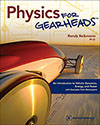|
Now Available! |
Physics for Gearheads
Price: $119.95
|

Gearheads 4 Life - Fall / Winter 2015
BOOK REVIEW
Physics for Gearheads has to be one of the most challenging books I've read since I finished school. That may not sound like a glowing review, but my intention is purely positive. It wasn't until after I left school that I realized the basis for nearly every technical question ever addressed for a high-performance automobile could be neatly summarized wirh basic physics and its accompanying math.
Author Randy Beikmann has a Ph. D. in mechanical engineering and has taken the complex subject matter of how physics relates to the automotive world. The book is broken down into 17 chapters to help you understand how physics affects everyday decisions we make about performance cars. Beikmann addresses this by emphasizing that we must at least acknowledge the existence of basic laws of physics if we expect to avoid potential headaches later on.
It's discouraging when you realize that your new idea on making more horsepower won't pass muster because it overlooks the laws of physics.
Physics for Gearheads has chapters dealing with forces, torque, motion dynamics, energy applications, and the basics of power among many others. Beikmann also gets into fun stuff like center of gravity calculations, load distribution within a race car, and other topics true gearheads will find entertaining. In each of these chapters, he takes the obscure theory and applies it directly to an automobile so the reader can become familiar with the theory by seeing it applied in a real-world automotive application.
I won't sugar coat this. Physics for Gearheads is 600 pages and while the subject matter is about high performance cars and racing, this is rough sledding for those of us with limited math skills. However, this book is enormously helpful with hundreds of formulas intended to guide you through the math when faced with a question that can only be solved with numbers.
For example, Beikmann offers math-based proof for why taking the preferred line on a race track will generate quicker lap times, or why gasoline is an excellent energy choice compared to other forms of energy. For engine fans, there's a chapter on Power Basics where Beikmann gets into power, acceleration, and parasitic losses. Among the best parts of this chapter is his treatment on traction, power, and gearing, all of which directly relate to performance enthusiasts. There's even a chart that lists formulas for determining acceleration based on traction limits. These are the same formulas used to create the drag strip simulations computer programs that are now so easily accepted.
Beikmann quickly mentions kinetic energy in rotation as it relates to a flywheel. As an example when a flywheel spins, it creates kinetic energy. He notes that by doubling the speed of a given weight flywheel from 3,000 to 6,000 rpm, the kinetic energy is quadrupled.
This explains why raising the launch rpm allows a race car to leave that much harder, assuming traction is maintained. It's not so much that the engine is making more power but that the kinetic energy stored in the spinning flywheel releases that energy as the clutch is engaged. This is also the reason why Indy cars spin the tires when leaving the pits, since their flywheel and clutch is so small and light that it stores very little energy. The driver has to raise the launch rpm high enough to spin the tires so the engine doesn't stall while leaving the pits.
But don't let all the formulas and equations in this book scare you away. If you have always wondered about the real origins of how the physics is applied when it comes to high-performance automobiles, chances are your questions are covered in this book. I know it has already earned a prime spot as a valued reference on my bookshelf.

Review from and courtesy of Gearheads 4 Life - Fall / Winter 2015
http://www.gearheads4life.com/print-magazine/gearheads4life-fallwinter-2015-print-magazine/
![[B] Bentley Publishers](http://assets1.bentleypublishers.com/images/bentley-logos/bp-banner-234x60-bookblue.jpg)
